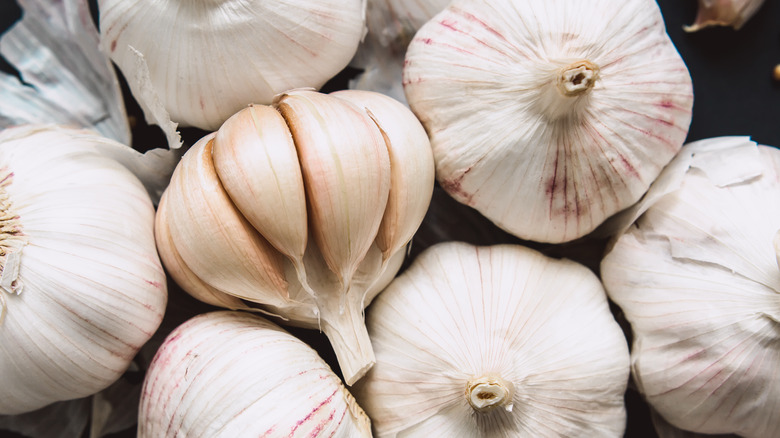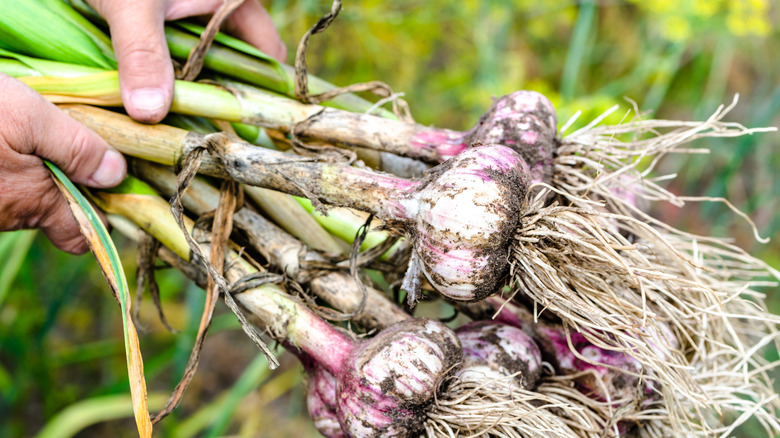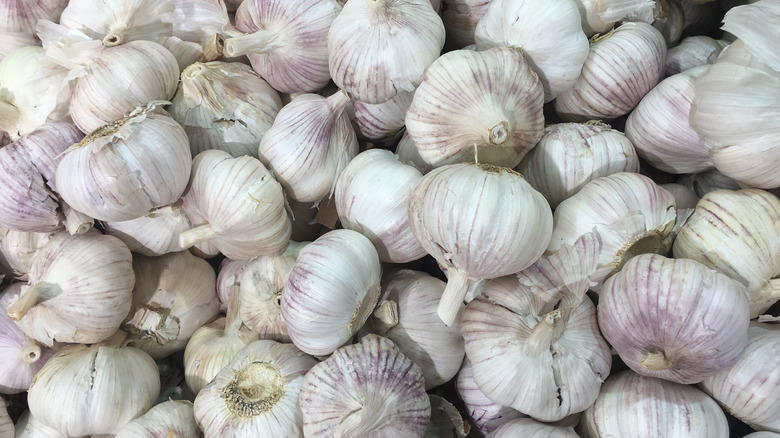Will There Be Another Garlic Shortage In Fall 2021?
Last year, the spread of the COVID-19 pandemic across the globe saw numerous countries suffering from widespread garlic shortages (via Fresh Plaza). Between border closures and the increased demand for cloves thanks to nearly everyone cooking food at home, the prices of the beloved, fragrant bulbs spiked rapidly, with many U.S. producers turning to imports from China. It was an undoubtedly frustrating time for everyone, whether you were a farmer, shopkeeper, restaurant owner, or someone who simply couldn't get enough of Ina Garten's infamous 40-clove garlic chicken (via Barefoot Contessa).
According to The New York Times, widespread droughts and reports from Produce Blue Book on decreased garlic yields suggest the world now heads toward yet another garlic shortage this fall. This news comes at a time when demand is surging for fresh bulbs, along with other staple ingredients, as restaurants reopen across the U.S. (via Today). Factor in how the Delta variant already affects the cost of food, and it's likely consumers should expect to see far less garlic on shelves than they normally do over the next few months.
Hot weather is affecting the garlic crop
While some U.S. farms continue to do everything they can to ensure they harvest enough garlic domestically to meet demands for the fall season, external factors like harsh weather may still create problems for the garlic supply chain, particularly producers on the West Coast. According to California Farmland Trust, California supplies approximately 90% of all the commercially-grown garlic in the U.S. but currently faces one of the worst droughts since 1977 due to its recent pattern of dry, extreme heat (via Reuters). According to The New York Times, experts have predicted high temperatures should continue through fall, which will likely contribute to water shortages and wildfires that reduce the number of overall crops.
Even for those who remain determined to harvest garlic and other high-demand crops, the process remains costly. Salvador Parra, a manager at Burford ranch in California, told Reuters back in June that he and other West Coast farmers have turned to expensive emergency water pumps to keep their crops alive for the summer. As a result, Parra said many farmers have had to grow fewer crops, while also raising prices just to break even. For consumers, this means you may have to pay a premium on U.S. garlic this fall.
Local garlic returns to stores
Before you give up on making that garlic roast chicken for the holiday season, you should know a shortage doesn't necessarily mean garlic will totally disappear. It just means it may come with a more expensive price tag than you're used to seeing, particularly if you need to stock up on fresh bulbs (via Produce Blue Book). This price increase stems from the fact that suppliers may have to rely on locally grown harvests, as imports should slow down through the fall. Of course, while this means fresh garlic bulbs may not be as abundant or cheap as they usually are, some consumers could see this as a positive, as it puts more money back into domestic farmers' hands.
A representative from Christopher Ranch, a leading garlic producer in California, said the company planned to compensate for the increased garlic demand by focusing on developing heirloom garlic varieties, while also minding how much garlic they produce as to not create any waste. "We've been closely managing our inventories to ensure minimal disruption to supply chains," the representative told Produce Blue Book. Either way, you can't go wrong stocking up on garlic salt and jarred minced garlic just to play it safe.


